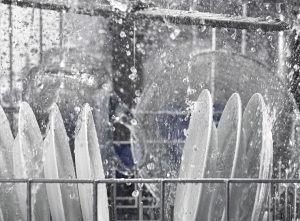Did You Use a Wet Dispenser Cup?
This sounds obvious, but if you’re used to filling your dishwasher on autopilot, you may not have even noticed that the dispenser cup was wet. Although it may not seem like a big issue, a wet dispenser cup can cause the detergent to clump before the cycle even begins. It also means that you’re not putting the correct amount of detergent in the appliance, as there is likely to be detergent left over in the cup. So, if you notice detergent in your dispenser, check the detergent cup for any clumping. If you find some, you’ll need to clean out the cup and start over.
Did the Cycle Complete?
You may have developed a sixth sense for when your dishwasher cycle has finished and simply start unloading. Unfortunately, if the dishes were more heavily soiled or you used a different program, it may have taken a little longer than usual. This means that you interrupted the cycle and it did not have time to complete. This can allow detergent to become caked as it was left in the dishwasher. An issue like this is not likely to be the underlying cause of chronic detergent caking problems, but if this is an unusual occurrence, clean the detergent cup and start again.
Do You Have Old Detergent?
If you’re in the habit of looking for detergent deals, you may have bought massive boxes to take advantage of great savings. Unfortunately, when you buy larger boxes, it can allow the detergent to be exposed to air for a longer period. Older detergent tends to not dissolve well and will clump when exposed to air. This causes the dispenser door to become stuck to the detergent. You can resolve this issue by purchasing new detergent and ensuring that it is kept in a tightly sealed container. So, if you do like getting a bargain with those big boxes, don’t leave the detergent in the box with the flap open, transfer it to a sealed container and keep it in a dry and cool place. This means that you may need to stop keeping your detergent under the sink next to where your dishwasher heats up the wall of the cabinet.
Was the Wash Temperature Low?
The best wash and dry results are achieved with a water temperature of 120º F. This is the optimum temperature of water entering the appliance, so it is a good idea to check your water heater settings. Additionally, be sure that you choose the correct program to suit your dishwasher load.
Did You Use the Right Detergent and Amount?
Finally, did you use the correct detergent for your appliance and the correct amount of detergent? You should check the appliance owner’s manual for recommended detergents. Most appliances should only be used with automatic dishwashing detergent, but your dishwasher may require a specific type of detergent. You should only add the detergent just prior to starting the dishwasher cycle, and use the appropriate amount. More detergent doesn’t equal cleaner dishes. While too little detergent will mean that your dishes won’t be properly cleaned, if you use too much it can cause clumping and other issues such as glassware etching.
If you’re still having difficulties with a clogged detergent dispenser, you may need help from a professional home appliance repair technician. For help with any of your dishwasher repair needs, ensure you speak to a professional appliance repair service.
